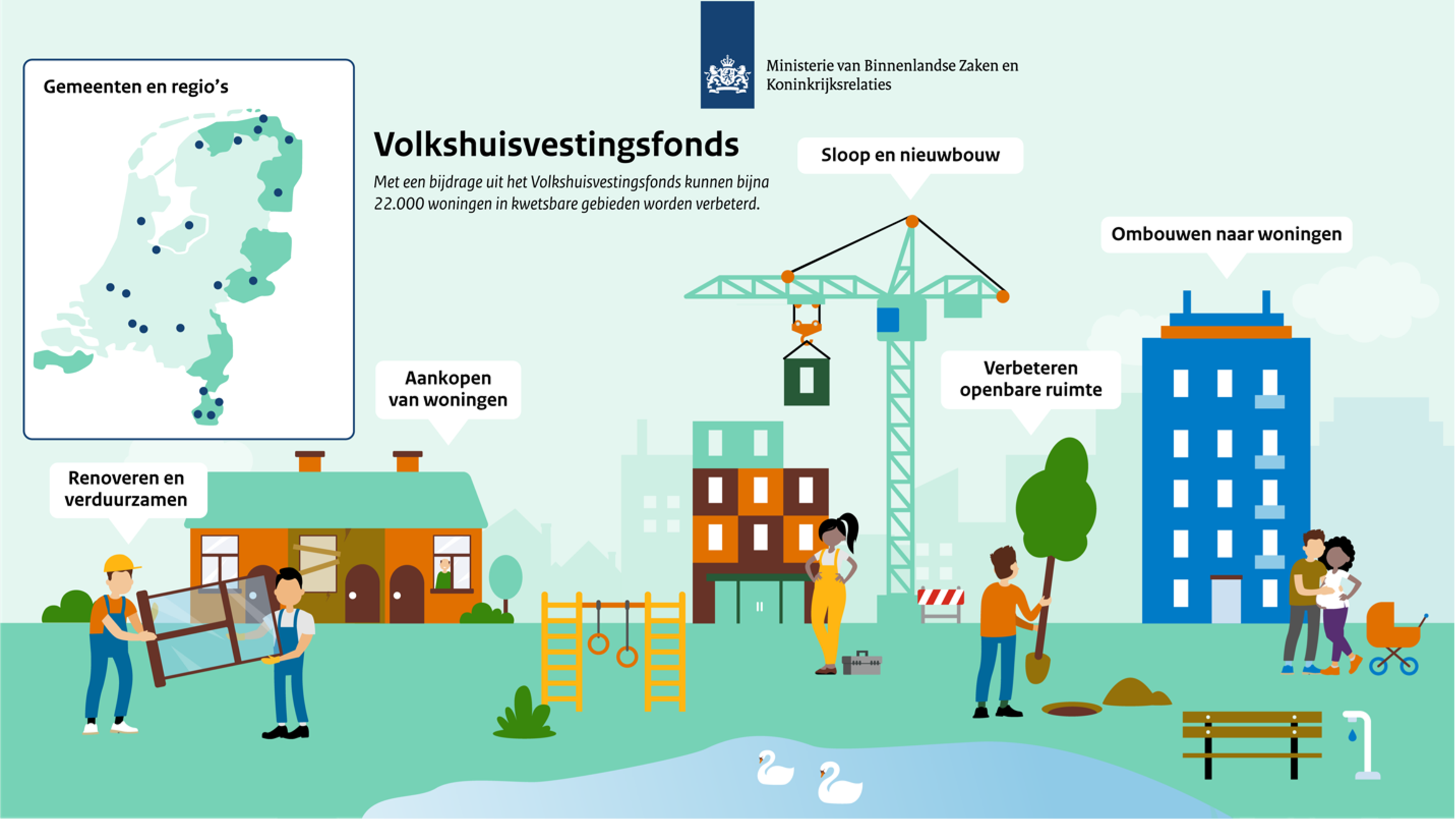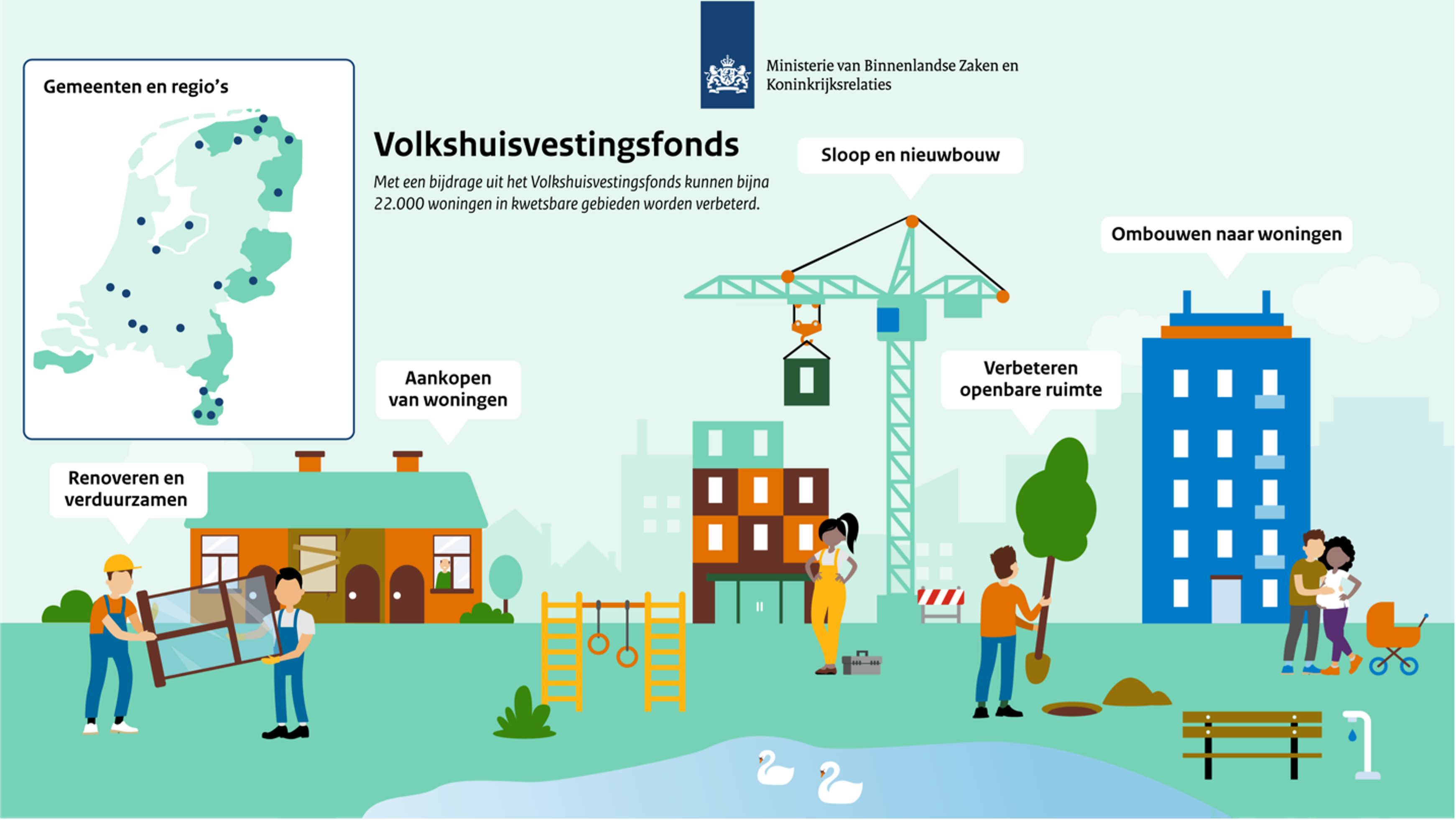A Combined Energy Efficiency and Levelling Up Scheme: the Dutch ‘Volkshuisvestingsfonds’
Created on 25-06-2024 | Updated on 25-09-2024
The Dutch ‘Volkshuisvestingsfonds’ (VHF) aims to address both energy efficiency and socio-economic disparities by targeting renovation subsidies to neighbourhoods with substandard housing and socio-economic deprivation. Initiated in 2021 by the Dutch Ministry of the Interior and Kingdom Relations (BZK), the VHF seeks to prevent the decline of disadvantaged neighborhoods by supporting the retrofitting and upgrading of existing housing stock, as well as the improvement of public spaces. The fund prioritises municipalities with urban renewal areas and regions with population decline. Despite its innovative design, the VHF faces implementation challenges such as high administrative burdens on municipalities, the need for sustained financial resources, and complexities in measuring long-term impacts. Moreover, stakeholder engagement, particularly involving private landlords, and compliance with EU state-aid legislation present additional hurdles. Addressing these issues is crucial for the VHF to achieve its dual objectives of enhancing energy efficiency and socio-economic upliftment.
Instrument
Subsidy fund
Issued (year)
2021
Application period (years)
2021-2024
Scope
Country
Target group
Deprived neighbourhoods
Housing tenure
Private rental sector (primarily)
Discipline
Public policy
Object of study
Instrument
Description
Efforts to target renovation subsidies, particularly in areas with households at risk of energy poverty, have gained prominence across Europe. However, the way in which policymakers and governments design and implement the targeting process varies greatly. Targeting energy poverty is rather difficult because it is a multifaceted issue and you have to identify which households both have limited means and high needs of energy due to their personal circumstances or the energy inefficiency of their home (Dubois, 2012). This case study zooms in on a peculiar example of such targeting: the Dutch Volkshuisvestingsfonds (VHF), in which national government asks municipalities to proof both that their housing stock is of substandard quality and that these dwellings are located in deprived neighbourhoods. This way, the fund tries to combine boosting the energy transition as well as aiming for ‘levelling up’ targets.
Background
Recognising the pressing need to address issues of liveability and housing quality, the Dutch Ministry of the Interior and Kingdom Relations (BZK) initiated the VHF in 2021 (Ministerie van BZK, 2021). The fund’s creation was influenced by rising concerns about housing conditions in socio-economically disadvantaged regions, where private homeowners and investors are facing significant barriers to maintaining and upgrading properties. A possible rationale is to avoid a downward spiral where the physical quality of a neighbourhood declines, prompting middle-income residents with more resources to leave, which in turn further worsens the overall quality of life in the neighbourhood (Andersen, 2002). Consequently, the primary goals of the VHF include the retrofitting of existing housing stock, demolition and reconstruction where necessary, and the enhancement of public spaces in neighbourhoods that are deemed relatively deprived. The fund aims to support private landlords with insufficient financial capacity and to a lesser extent housing associations.
Policy design and delivery
The VHF's design emphasises a targeted approach, where municipalities must demonstrate the substandard quality of their housing stock and the socio-economic deprivation of these neighbourhoods. Priority is given to urban renewal areas and regions facing population decline (see Figure 1). Municipalities are then allocated resources based on the severity of these conditions. Specific consultancy groups are appointed to assist municipalities in preparing their bids, ensuring that applications are robust and meet the stringent criteria set by the fund. The bid evaluation process involves a detailed scoring system that considers several factors: the extent of housing quality improvement, the anticipated socio-economic benefits, the energy efficiency gains, and the sustainability of the proposed interventions. Once a municipality's bid is approved, the funds are disbursed to the municipality, which then channels the money to the ultimate beneficiaries (hence, primarily private landlords with limited means). These beneficiaries must use the funds for approved renovation projects, with strict monitoring to ensure compliance and prevent misuse. In its first round in 2021, the fund distributed approximately €412.6 million, financing projects aimed at upgrading around 22,000 homes. As of summer 2024, the fourth round is open, now allocating €114 million.
One of the unique aspects of the VHF is its dual focus on energy efficiency and socio-economic uplifting. By linking housing improvements with broader ‘levelling up’ goals, the fund addresses both the physical infrastructure and the social dynamics of neighbourhoods. This way, it could be seen as a preventive measure that addresses the risk of self-reinforcing decline in which a neighbourhood’s physical quality degrades, leading to the exodus of middle-income residents. To do this, the VHF employs a data-driven approach to target and allocate funds. Municipalities are required to provide detailed data on housing conditions and socio-economic indicators. This data is used not only to evaluate the bids but also to monitor the progress and impact of the funded projects, which holds the promise of transparency and accountability, making it easier to measure the success of the interventions and to make necessary adjustments. Finally, the VHF encourages collaboration between the national government, municipalities, private firms, private landlords, and other stakeholders, making it a comprehensive public-private endeavour.
Challenges in implementation
Despite the innovative design and promising objectives, several critiques have emerged regarding its implementation. The official evaluation commissioned by the ministry noted that one significant concern is the high administrative burden placed on municipalities, which makes the application process complex and resource-intensive (Eringfeld et al., 2022). This complexity can disadvantage smaller municipalities or those with less capacity, exacerbating regional inequalities. Additionally, they claim there is a need for a more permanent flow of financial resources to ensure the sustainability of improvements and to fund new projects continually. The report also highlights challenges in measuring the long-term impact of funded projects, particularly concerning socio-economic benefits and energy efficiency gains, necessitating more robust mechanisms for impact assessment.
Another critique centres on stakeholder engagement, with some municipalities struggling to involve private landlords and residents effectively in planning and implementation. Regulatory challenges further complicate efficient project execution, particularly compliance with EU state-aid legislation. Moreover, there is concern that subsidising private landlords with public money may have a regressive impact on income and wealth distribution, as it ultimately provides a housing value premium to private landlords (Fernández et al., 2024).
Alignment with project research areas
The Volkshuisvestingsfonds aligns with my research project by addressing the tensions between housing affordability and sustainability. By supporting municipalities with substandard housing and socio-economic deprivation, and allocating resources based on these conditions’ severity, the fund tries to ensure that aid reaches the areas that are most in need. Notably, the fund takes a distinctively Dutch approach, targeting improvements at the neighbourhood level rather than individual households, which enhances overall liveability. Moreover, the fund's focus on effective resource utilisation aligns with my project's goal of enhancing policy impact and public accountability. Its innovative, data-driven monitoring system is commendable, though the high administrative burden requires critical assessment as it diverts valuable resources needed for achieving a just transition towards sustainable housing. This interplay has been central to my recent work on energy poverty and just transition governance, emphasising the importance of recognitional justice and effective multilevel governance frameworks in addressing energy poverty across Europe.
References
Andersen, H. S. (2002). Can Deprived Housing Areas Be Revitalised? Efforts against Segregation and Neighbourhood Decay in Denmark and Europe. Urban Studies, 39(4), 767-790. https://doi.org/10.1080/0042098022011956
Dubois, U. (2012). From targeting to implementation: The role of identification of fuel poor households. Energy Policy, 49, 107-115. https://doi.org/10.1016/j.enpol.2011.11.087
Eringfeld, W., Geuting, E., Lucassen, M., & Thomasia, M. (2022). Reflectie op de regeling van het Volkshuisvestingsfonds (VHF). https://www.volkshuisvestingnederland.nl/binaries/volkshuisvestingnederland/documenten/rapporten/2022/01/31/reflectie-op-de-regeling-van-het-volkshuisvestingsfonds-vhf/rapport-reflectie-op-de-regeling-van-het-volkshuisvestingfonds-vhf.pdf
Fernández, A., Haffner, M., & Elsinga, M. (2024). Subsidies or green taxes? Evaluating the distributional effects of housing renovation policies among Dutch households. Journal of Housing and the Built Environment. https://doi.org/10.1007/s10901-024-10118-5
Ministerie van BZK. (2021). Regeling specifieke uitkering herstructurering volkshuisvesting. https://wetten.overheid.nl/BWBR0044932/2021-05-0
Related vocabulary
Energy Poverty
Financial Wellbeing
Just Transition
Area: Policy and financing
Created on 17-10-2023
Read more ->Area: Design, planning and building
Created on 14-10-2024
Read more ->Area: Policy and financing
Created on 03-06-2022
Read more ->


